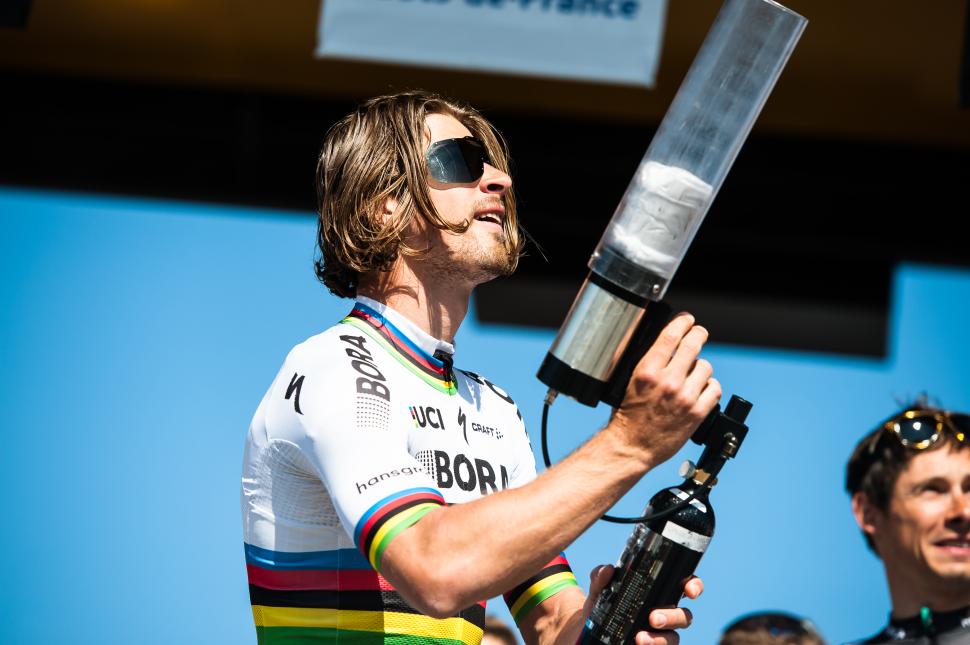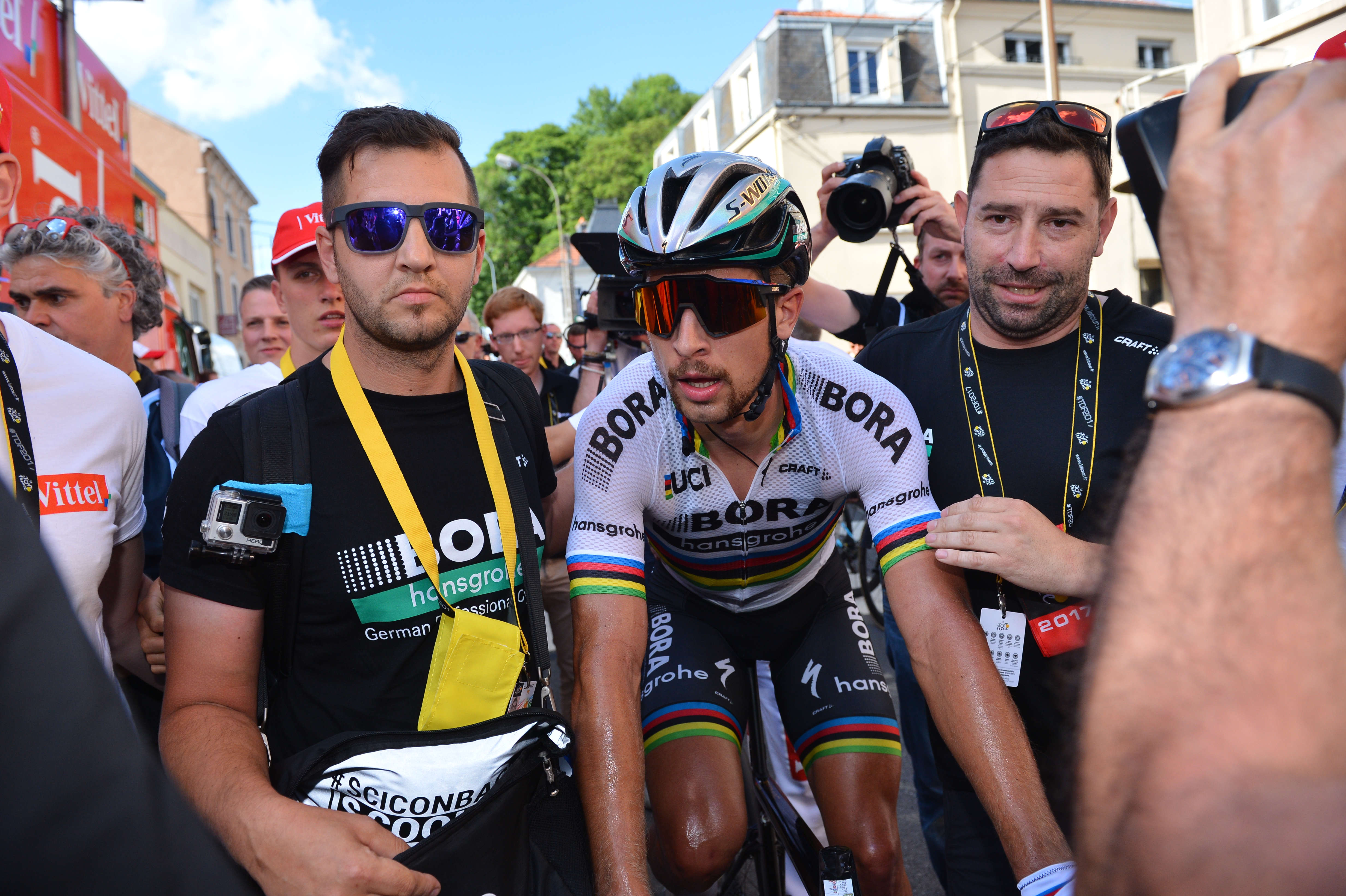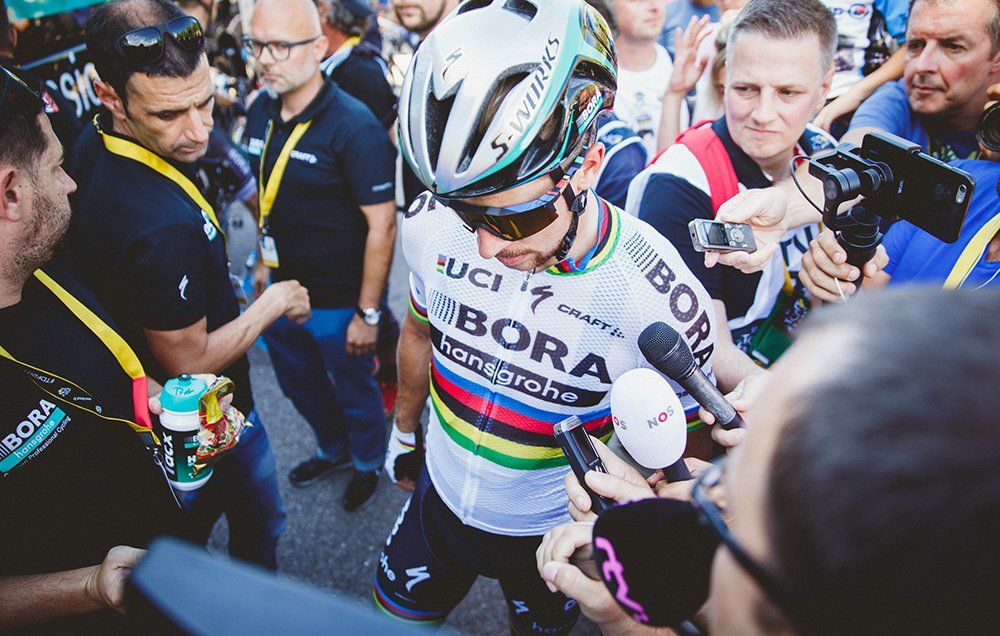
At the end of June, one of the most successful, flamboyant, and iconic cycling icons of the twenty-first century crossed the finish line of a road race for the final time. Riding for the little-known but colorfully named Pierre Baguette team, Peter Sagan, one of the sport’s greatest winning machines, finished 85th on the fifth and final stage of the Tour of Slovakia, his home race.
A few weeks later, the 34-year-old officially ended his momentous 14-year career, this time off-road, racing and finishing second at the Slovakian national mountain bike championships, nearly a year to the day after sprinting to 11th on the Champs-Élysées in Paris, where he admitted, in typically candid fashion, that he was glad to see the Tour de France end.
The Sagan era, coined by awestruck critics to describe the decade in which the Slovakian dominated the racing scene, has come to an end.
Peter Sagan, 2023 World Mountain Biking Championships (Michal Cerveny/SWpix.com).
(Michal Cerveny, SWpix.com)
And, while Sagan’s later years at Bora-Hansgrohe and TotalEnergies were an unavoidable example of fading powers and diminishing returns, the Slovakian’s record since bursting onto the scene as a precocious and frighteningly gifted 20-year-old at the 2010 Paris-Nice speaks for itself.
121 professional victories in 14 years. Between 2015 and 2017, he won three world road race titles, becoming the joint record holder and the only male rider to win all three rainbow jerseys in a row. Seven green jerseys at the Tour de France (another record). 12 Tour de France stage victories. Paris-Roubaix. The Tour of Flanders. The Tour de Suisse included a record 18 stages. There have been three editions of Gent-Wevelgem. Stage victories in all three Grand Tours.
However, as anyone who witnessed Sagan in his brilliant, freewheeling peak will attest, the results sheet does not tell the whole picture.
There was the swashbuckling, showboating style, the blistering uphill sprint, the long-range attacks, and the astounding all-round ability that arguably played a pioneering role in ridding professional men’s cycling of its decades-long fixation on specialism, ushering in the current era of Flanders-winning grand tour riders.
swashbuckling, showboating style, the blistering uphill sprint, the long-range attacks, and the astounding all-round ability that arguably played a pioneering role in ridding professional men’s cycling of its decades-long fixation on specialism, ushering in the current era of Flanders-winning grand tour riders.
Road.cc on WhatsApp.
All the newest road cycling news, technology, and shopping tips delivered directly to your phone.Follow our WhatsApp channel here.
There were the wheelies, the devil-may-care approach to sprinting, the personality that transcended cycling, the viral stunts, the mid-race autographs, the Grease parody videos, the controversies, the bad decisions, the oversized podium goggles, the iconic celebrations, the internal team pressures, the post-victory quips, the beer adverts, the stopping to fix a cyclo-tourist’s puncture, the unerring ability to draw the attention of every fan, pundit, and rival at every m
Peter Sagan, 2016 Tour de France. (Simon Wilkinson/SWpix.com)
(Simon Wilkinson, SWpix.com)
In a nutshell, Peter Sagan was the iconic cyclist of his era.
The Slovakian was the face of a generation that, along with Michael Matthews, Tom Dumoulin, Romain Bardet, Thibaut Pinot, and Nairo Quintana (all born in 1990), left an indelible mark on most, if not all, of cycling’s biggest races in the 2010s, but has gradually faded into the background in recent years as a new wave of audacious talent emerged.
While Sagan set the benchmark for audacity, the Van der Poels, Van Aerts, and Pogačars of the peloton have strived to match and surpass in the 2020s. However, unless you’re Mark Cavendish, even the greats aren’t guaranteed to go out at the top in a sport as tough and cruel as cycling.
So it proved for Sagan.
Peter Sagan in the 2022 E3 Saxo Bank Classic (Zac Williams/SWpix.com).
(Zac Williams / SWpix.com)
An unimpressive final few years with an ill-fitting TotalEnergies team ushered in one last shot at Olympic success on his first love, the mountain bike. But major health concerns earlier this year, including a tachycardic episode and two separate heart surgeries, as well as Slovakia’s failure to qualify for Paris, put an end to that final hope.
Sagan clarifies in an interview with road.cc that the Olympics did not determine his final year as a professional.
“First of all, I’d like to point out that qualifying for the Paris Olympics was almost impossible, and we were aware of that, so my goal was to enjoy the mountain biking experience as much as possible with my friends at Specialized,” the woman, 34, told road.cc.
“Unfortunately, things did not go as planned due to the health challenges I encountered. Despite this setback, my aspirations for off-road racing remain unchanged. I will continue to love mountain biking without aiming for top-level racing.
Peter Sagan, 2023 World Mountain Biking Championships (Michal Cerveny/SWpix.com).
Sagan races and finishes 37th in the 2023 mountain bike championships in Peebles. (Michal Cerveny/SWpix.com)
And, as it has been throughout his racing career, enjoyment remained high on Sagan’s list of priorities for 2024, regardless of Olympic qualification, with a home farewell at the Tour of Slovakia adding the finishing touch.
“It was fantastic to be surrounded by the support and love of my fellow Slovaks and I think I couldn’t have asked for a more perfect place,” according to him. “It was an incredible and memorable event for me. Now that this chapter of my career has come to an end, I’m setting new ambitions for myself.”
Before riding off into the sunset in pursuit of those new goals, which include a partnership with online training and racing platform MyWhoosh (where the three-time world champion’s personal workouts will be available to all users), a reflective Sagan spoke with road.cc about his illustrious career on the road, his legacy as a rider, and why, despite his long-held status as the world’s greatest and most famous bike racer, he was still just the same Peter Sagan.
road.cc: What have you been up to since leaving racing?
Peter Sagan: In the weeks following the Tour of Slovakia, I spent valuable time with my family, particularly my son Marlon, while maintaining a consistent and regular training plan both indoors and outdoors. I’ve recently discovered the new world of indoor riding on MyWhoosh, which I think is a great way to stay active while still having fun.
Looking back on your career, you debuted in 2010, at the age of 20, winning two stages at Paris-Nice, as well as stages at the Tour de Romandie and the Tour of California. As a first-year professional, did you anticipate to be that successful so soon? And how did you adjust to becoming such a crucial rider for Liquigas so quickly?

I had hoped to win early in my first year as a professional rider, but there was no way of knowing when, when, or how that would happen. My two stage victories in Paris-Nice were a dream come true. Despite my early results, I was not promoted to a leadership position at Liquigas. At the time, the team already had two highly successful and prominent riders, Ivan Basso and Vincenzo Nibali, while I was a rookie.
Peter Sagan at the 2014 Tour de France (Alex Whitehead/SWpix.com).
(Alex Whitehead / SWpix.com)
Pro cycling has changed dramatically since you started pro in 2010; you even competed against Lance Armstrong in your debut race for Liquigas at the Tour Down Under. What are the most significant changes you’ve seen in the peloton over the last 14 years? Has the sport changed for the better?
Over the last 14 years, professional cycling has undergone several changes, some favorable and some detrimental. Since 2010, I believe the peloton has lost a feeling of respect for itself. However, I’ll leave it to you to determine whether these adjustments were for the better or worse overall.
One of these changes is the peloton’s increasingly youthful complexion, which may have started with your early success. What advise would you provide to Remco Evenepoel and Juan Ayuso on how to prolong their careers and maximize their potential?
It is not my business to give counsel to Remco and Juan, two excellent young riders who, in any case, I do not believe require it. I’d want to point out that, while my career was successful, and I always gave my all, it didn’t last long. I had many delightful moments, even beyond the achievements, but I do not feel qualified to offer such advice.
What are your career highlights, or the most memorable moments for you personally? Any regrets?
Aside from the birth of my son, which I consider the most wonderful event of my life, both emotionally and professionally, my three world championship titles are unquestionably the pinnacles of my career.
Peter Sagan wins the 2016 Road World Championships (Alex Whitehead/SWpix.com).
Sagan earns the second of his three rainbow jerseys in Qatar in 2016. (Alex Whitehead/SWpix.com).
I have no regrets for two primary reasons. First, in every race, regardless of its prominence, I always give my all. When I cross the finish line, I know I’ve achieved my best result for the day. Second, dwelling on the past and things beyond your control is pointless. Instead, take lessons from each failure and win and apply them.
Last year, you declared you were ‘happy’ your farewell tour was ended. Why?
I had previously indicated that this would be my final season on the WorldTour, and the Tour de France, the sport’s biggest and most beautiful race, was the ideal way to conclude such an important chapter in my life. The Tour de France has given me so much, making this occasion especially memorable.
Peter Sagan Celebration.JPG
You were one of the best classics riders of your generation, but you were best known for wearing the green jersey during the Tour de France. Was it simple to stay motivated to succeed on the Tour, and what does winning green seven times, an all-time record, signify for your future?
Maintaining motivation during the Tour de France is nearly a given. Even if you’re actually suffering, the knowledge that you’re competing in the Tour de France motivates you to give it your all. The green jersey has always been a personal objective for me, as well as a team goal. Winning seven times is a true honour and privilege.
/origin-imgresizer.eurosport.com/2017/07/05/2121537-44387950-2560-1440.jpg)
Some saw you as quiet and introverted early in your career, but you swiftly turned into one of the sport’s greatest showmen, performing wheelies, making amusing films, and generally entertaining. What inspired you to showcase that aspect of your personality, and did it come naturally to you as a public figure?
I’ve never tried to’show off’ any facet of my personality; it was never my objective. I’ve always been honest to myself, from the beginning till today. People’s perception of me as’shy and introverted’ was most likely owing to my low language skills at the time. Over the years, I have spent time and effort to learning various languages in order to improve my communication skills.
Peter Sagan, 2017 Paris-Roubaix. (ASO and Pauline Ballet)
It makes me glad that the audience perceives me as both a successful rider and a showman. However, I’ve always remained the same person and never felt compelled to act differently than who I am. It has always been the same Peter Sagan.
Obviously, as perhaps the biggest name in the sport throughout the 2010s, you were under a lot of pressure to produce significant results, both from the press and fans, but also from within your own team (most famously with Oleg Tinkov while riding for Tinkoff-Saxo in 2015 and 2016). How did you deal with the pressure, and do you think it affected your results, either positively or negatively?
Oleg Tinkov has surely contributed significantly to both my professional and personal development. Fortunately, I never regarded pressure to be a major foe of mine, and I was fortunate to have the support of Giovanni Lombardi and Gabriele Uboldi [Sagan’s agent and press officer, respectively]. Together, they efficiently ease most of the stress that would otherwise befall me.
On a similar vein, you were one of the few true all-rounders in the peloton, particularly in your early years, when you were infiltrating breaks in the mountains during the Tour and competing bunch sprints the next day. Was there any pressure on you to specialize as a cobbled classics racer, focusing on races like Flanders and Roubaix?
No, there was never any pressure; it was a natural progression, both physically and intellectually.
Peter Sagan’s Paris-Roubaix-winning Specialized S-Works Roubaix (photo source Specialized and Brakethrough Media).
It’s evident, however, that your all-around ability made you a target, and your opponents occasionally refused to work with you in breakaways or classics. Were you aware of your standing within the peloton, and did it influence how you raced?
Throughout my career, my goal has been to give it my all and win every race. When it was not possible, I aimed to get the best possible outcome and return home satisfied with my efforts. My teammates have always been completely supportive of me, whereas my adversaries have pursued their own plans to reach the same goals I have. In the peloton, all riders do their best to achieve their individual and team goals.
In recent years, there has been a surge of riders with similar traits to you who can win on a variety of terrain, led by Wout van Aert and Mathieu van der Poel. What do you think of cycling’s recent move from an emphasis on specialty sprinters, climbers, and puncheurs to riders who want to win all year long in a variety of races?

I’m thrilled to be witnessing such a dynamic moment in cycling, where we have so many excellent riders capable of winning on any given day, race, or stage. Along with Wout and Mathieu, we must recognize Tadej, Jonas, and Remco, who together form an amazing group of riders.
In 2018, Peter Sagan participated in the Tour de France with ASO/Pauline Ballet.
Perhaps ironically, if you were starting out in the sport now, do you think you would have had more chances to win at races like Flanders, Sanremo, or grand tour stages if you didn’t have the burden of being the only rider, or one of the very few riders, with those all-round abilities that are now commonplace?
I don’t think I’m qualified to address this question. I can only say that I am pleased with what I have accomplished over my career. It would be quite tough to predict how I would perform in today’s peloton.

Leave a Reply